Share this
Flanges are commonly used in piping systems to connect pipes, valves, pumps, and other equipment. They are typically made of metal, such as carbon steel, or stainless steel. Here are the general steps for manufacturing flanges:
Raw material selection:
The material for the flanges is selected based on the requirements of the application, such as the temperature, pressure, and chemical compatibility of the fluid being transported.
Cutting:
The raw material is cut into the required size and shape for the flange using machines such as saws, plasma cutters, or lasers.
Forming:
The cut material is then formed into the shape of a flange using a press or forging machine. This process involves applying pressure to the material to mold it into the desired shape.
Heat treatment:
Depending on the material and application, the flange may need to be heat treated to improve its strength, toughness, and resistance to corrosion.
Machining:
The flange is machined to create the desired finish and dimensions. This involves using machines such as lathes, drills, and milling machines to remove material from the surface and create the required features such as bolt holes and grooves.
Quality control:
The finished flange is inspected to ensure that it meets the required specifications for dimensions, finish, and material properties.
Surface treatment:
Depending on the application, the flange may be coated with a protective layer such as paint, powder coating, or galvanizing to improve its corrosion resistance and durability.
Once the flanges have been manufactured, they are typically packaged and shipped to the customer for installation in their piping system.
For pipe fittings, please link: https://bekingpiping.com

